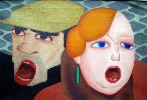[11] Christelijcke Klachte a4 (anonieme zetting a4, 1647)
Na Camphuysens dood bleven zijn Stichtelycke Rymen nog een eeuw lang herdrukt worden. Een bijzondere uitgave is die uit 1647 door Jacob Aertsz. Colom, doopsgezind boekverkoper te Amsterdam en groot bewonderaar van Camphuysen, die hij nog persoonlijk zegt te hebben gekend. Zijn bewondering ging zover dat hij de doodgraver van Dokkum, waar Camphuysen begraven lag, omkocht om 's dichters schedel te bemachtigen. Die heeft hij tot zijn dood bewaard.
Colom lijkt in 1647 kosten noch moeite te hebben gespaard om een prachtuitgave van de Stichtelycke Rymen op de markt te brengen. Hij liet gravures maken bij de liederen en voorzag ze zelf van korte rijmpjes, zodat het liedboek feitelijk een fraaie embleembundel werd. Ook liet hij vierstemmige muziek componeren bij een van Camphuysens liederen: 'Traen ooghen traen' op de melodie van Dowlands Lacrymae [track 11]. Dit is een curieuze compositie geworden, waarin de opeenvolgende muzikale gedachten van de Engelse liedmelodie telkens door de stemmen heen worden geïmiteerd. Zo wordt Dowlands melancholieke ayre een doorwrocht Nederlands motet.
De naam van de componist onthult Colom niet. Cornelis de Leeuw is wel geopperd, maar de bas van de vierstemmige zetting in de Stichtelycke rymen van 1647 blijkt niet overeen te komen met de basso continuo van De Leeuw's eveneens vierstemmige zetting van 'Traen, oogen, traen' in diens uitgave van Camphuysens Stichtelycke rymen 'op Musijck gebracht met 3, 4, 5, 6, 7, en 8 stemmen, met Bas-Continuo, door Cornelis J. Leeuw, Edammer' (1646), waarvan alleen de basso continuopartij is overgeleverd. Dat maakt De Leeuw's auteurschap van de zetting uit 1647 minder waarschijnlijk - of hij zou binnen het jaar een soortgelijke zetting van dezelfde tekst moeten hebben uitgebracht.
Pavaen Lachrimae a4. Duodecimi Toni.
Christelijcke Klachte
Zang: Doulants Lacrymae [John Dowland]
Traen, oogen, traen, en word fonteynen
Door u veel weynen;
Benaude borst, zen' door de lucht
Een droef gezucht.
Weyn mede, weyn, al ghy oprechte,
Weyn, Godes knechten;
Laet klaght verselschapt met getraen
Ten Hemel gaen.
Laet als twee beecken,/ Uw oogen leecken,
Om den mensch (helaes!)
Die (in 't hert/ Staêgh benert,/ En verwert
Door qua waen van vreuchd en smert)
Zoeckend' heyl, van heyl ververt, (*1)
Teffens wijs en dwaes.
Geheel Nature/ Wil mede truren;
Truer wat truren kont;
Al 't verdriet/ 't Welckmen ziet/ Dat geschiedt,
En de wer'lt van overvliet,
Is zoo trurens waerdigh niet
Als des Menschen Zondt.
Wel liet ghy staegh tranen vlieten,
Heraclite; (*2)
't Is gewis droeff'nis, te zien
De jamm'ren die op Aerdt geschien.
Met meer reden weenen d'oogen
Die zien mogen
Wat voor Schat en Padt Godt geeft
Daer 't domme hert geen lust in heeft.
(*1) zich verwijdert.
(*2) Heraclitus: Ionisch natuurfilosoof uit de 6e eeuw v. Chr. ('panta rhei'), die voortdurend zou hebben geweend om de dwaasheden der mensen. | [11] Christian Lament a4 (anonymous setting a4, 1647)
After Camphuysen's death, his Stichtelycke Rymen remained in print for another century. One remarkable edition is that of 1647 by Jacob Aertsz. Colom, a Mennonite bookseller in Amsterdam and a great admirer of Camphuysen, whom he said he had known personally. His admiration went so far that he bribed the gravedigger of Dokkum, where Camphuysen lay buried, to get the poet's skull. This he kept until his death.
Colom appears to have spared neither money nor effort in 1647 to publish a luxury edition of the Stichtelycke Rymen. He had engravings made to go with the songs, and furnished those himself with short rhymes, so that the songbook in fact became a beautiful emblem book. He also had four-part music composed to go with one of Camphuysen's songs: 'Traen ooghen traen', set to the melody of Dowlands Lacrymae [track 11]. This became a curious composition, in which the successive musical thoughts of the English melody are constantly imitated throughout the voices, making Dowland's melancholy ayre into a thoroughly worked-out Netherlandish motet.
Colom did not reveal the name of the composer. Cornelis de Leeuw has been proposed, but the bass line of the four-part setting in the Stichtelycke rymen of 1647 does not match the basso continuo of De Leeuw's setting, also in four parts, of 'Traen, oogen, traen' in his own edition of Camphuysen's Stichtelycke rymen 'op Musijck gebracht met 3, 4, 5, 6, 7, en 8 stemmen, met Bas-Continuo, door Cornelis J. Leeuw, Edammer' [Edifying Rhymes set to music in 3, 4, 5, 6, 7, and 8 voices, with basso continuo, by Cornelis J. Leeuw of Edam] (1646), of which only the basso continuo part has survived. That makes De Leeuw's authorship of the 1647 setting less likely, unless he produced a similar setting of the same text within the same year.
Pavaen Lachrimae a4. Mode Twelve.
Christian Lament
Melody: Doulants Lachrymae [John Dowland]
Weep, eyes, weep, and become fountains
From an overflow of wailing;
Anxious breast, send through the air
A sad sigh.
Wail along, wail, all you upright;
Wail, God's servants;
Let sighs rise toward Heaven; / Let lament accompanied by tears
Let laments begin. / rise to Heaven.
Let your eyes flow like two streams,
Mourning mankind (alas!)
Which (at heart, always distressed and confused
By evil delusions of pleasure and pain
Seeking salvation, misses the mark,
Both wise and foolish.
All of Nature weeps in sympathy;
Mourning what can be mourned
All the sorrow, to be seen, that happens,
That overflows the world,
All of that is less worthy of mourning
Than Human Sin is.
You were right to let your tears always flow
Heraclitus, (*1)
It is indeed sorrow to see
The miseries that occur on Earth.
With more reason the eyes weep
To be able to see
What treasures and traces God gives
That the foolish heart has no desire for.
(*1) Heraclitus: Greek natural philosopher from the sixth century BC who was said to have wept constantly at human foolishness.
Translation: Ruth van Baak Griffioen |

